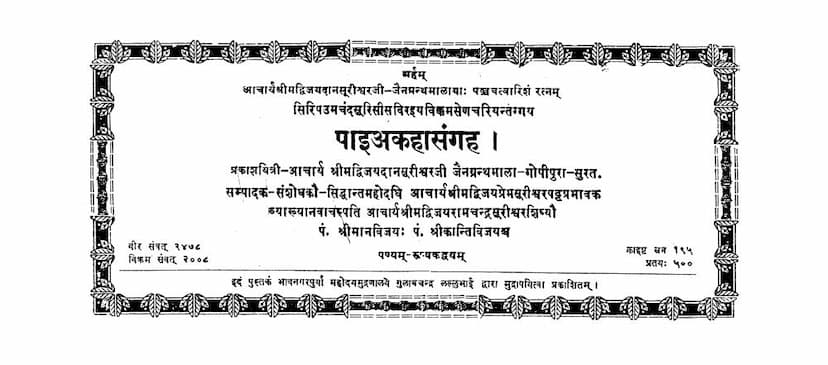Paiakaha Sangaha
Added to library: September 2, 2025

Summary
This is a comprehensive summary of the Jain text "Paiakaha Sangaha" (प्राकृत कथा संग्रह), edited by Manvijay and Kantivijay, and published by Vijaydansuri Jain Granthmala. The catalog link provided is https://jainqq.org/explore/034180/1.
Book Title: Paiakaha Sangaha (प्राकृत कथा संग्रह) Author(s): Manvijay, Kantivijay Publisher: Vijaydansuri Jain Granthmala
Overview:
"Paiakaha Sangaha" is a collection of fourteen Prakrit stories drawn from the "Sirivikkamasenachariya" (श्री विक्रमसेन चरित) composed by Acharya Siripadmachandra Suri's disciple. Out of the original fourteen stories, twelve were found and are presented in this compilation. These stories are categorized and explained based on various virtues and principles of Jainism, such as Dan (Charity), Sheel (Virtue/Chastity), Tap (Austerity), Bhavna (Meditation/Contemplation), Samyaktva (Right Faith), Navkar (Recitation of the Navkar Mantra), and Anityata (Impermanence).
Editorial Note:
The editors, Pandit Shree Manvijayji and Pandit Shree Kantivijayji, both disciples of Acharya Shree Vijaypremsurishwarji and Acharya Shree Vijayramchandrasurishwarji, have meticulously edited and compiled these stories. They express gratitude for the support received from various Jain Bhandars (libraries), particularly the Patan Sanghvi Pada Bhandar and the Tapagachhiya Bhandar. The book includes a detailed index of the stories, an introduction to the text's importance, and information about the manuscripts used.
Key Virtues and Stories Presented:
The book is structured around the following themes, each illustrated with one or more stories:
-
Dan Vishaye (Regarding Charity):
- Dhanadev Dhanadatt Katha (धनदेव धनदत्त कथा): This story highlights the immense benefits of charity. Dhanadev and Dhanadatt, brothers, engage in acts of charity, leading to prosperity and positive outcomes. The narrative follows their journeys, including adventures, encounters with snakes, and the rewards of their righteous deeds.
- Chand Govalkatha (चंडगोवालकथा): This story emphasizes that even seemingly simple acts of charity, when performed with sincere devotion, can lead to great spiritual and material rewards. Chand Govala's story illustrates the power of charity.
- Kripan Shresthikatha (कृपणश्रेष्ठिकथा): This tale focuses on the consequences of stinginess versus the virtues of generosity. The story of the miserly merchant contrasts with the positive outcomes of charitable acts.
-
Sheel Vishaye (Regarding Virtue/Chastity):
- Jayalakshmi Devi Katha (जयलक्ष्मीदेवी कथा): This story showcases the power of chastity and adherence to one's vows. Jayalakshmi Devi's unwavering commitment to her principles protects her from adversity and ultimately leads to happiness.
- Sundari Devi Katha (सुंदरीदेवी कथा): Similar to the previous story, this narrative highlights the strength and protective power of virtue and chastity. Sundari Devi's story exemplifies how maintaining one's character can overcome challenging situations.
-
Tap Vishaye (Regarding Austerity):
- Mrigankarekha Katha (मृगाङ्करेखा कथा): This story illustrates the efficacy of austerities and penance in overcoming karmic obstacles and achieving desired outcomes. Mrigankarekha's penance leads to the fulfillment of her wishes.
- Aghat Katha (अघटकथा): This tale emphasizes the transformative power of austerity in overcoming even severe karmic hindrances, demonstrating that nothing is impossible with the right spiritual practice.
-
Bhavna Vishaye (Regarding Meditation/Contemplation):
- Dharmadatt Katha (धर्मदत्त कथा): This story highlights the importance of right contemplation and intention behind actions. Dharmadatt's story demonstrates how righteous thoughts and feelings enhance the results of any deed.
- Bahubuddhi Katha (बहुबुद्धिकथा): This narrative suggests that while intelligence and knowledge are valuable, they are most effective when guided by proper contemplation and understanding.
-
Anityata Vishaye (Regarding Impermanence):
- Samudradatt Katha (समुद्रदत्त कथा): This story serves as a poignant reminder of the impermanence of worldly possessions, relationships, and life itself. Samudradatt's experiences underscore the transient nature of existence and the importance of focusing on eternal principles.
-
Samyaktva Prabhave (Due to Right Faith):
- Dhanashreshthi Katha (धनश्रेष्ठिकथा): This tale emphasizes the paramount importance of Samyaktva (right faith or perception). The story of Dhanashreshthi illustrates how unwavering faith can lead to prosperity and overcome even severe adversities.
-
Navkar Phale (Due to the Navkar Mantra):
- Saubhagya Sundar Katha (सौभाग्यसुन्दरकथा): This story showcases the immense power of reciting the Navkar mantra. Saubhagya Sundar's devotion and consistent recitation of the mantra lead to significant positive transformations in his life.
Manuscript Basis:
The editors relied on three palm-leaf manuscripts, designated as A, B, and C, for their compilation. Manuscript A, from the Patan Sanghvi Pada Bhandar, contains approximately sixty verses related to Vikramsen's life and the first to the eighth stories, ending with the story of Ghatkumar. Manuscript B, also from the same Bhandar, is more extensive, containing twelve stories from Vikramsen's life and also an additional text on grammar. Manuscript C, from the Tapagachhiya Bhandar, is shorter, containing only the story of Dhanadev-Dhanadatt. The editors note that some stories, like the one about Madansena and Kamal Shreshiputra, were not found in any of the available manuscripts.
Overall Significance:
"Paiakaha Sangaha" is a valuable resource for understanding Jain principles and ethics through engaging narratives. The stories serve as moral lessons, reinforcing the importance of virtues like charity, chastity, austerity, contemplation, right faith, and the power of sacred recitations like the Navkar mantra. The collection also imparts a deep understanding of the transient nature of worldly life and the ultimate spiritual goals in Jainism.